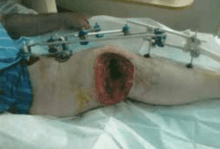Kneecapping
Kneecapping is a form of malicious wounding, often as torture, in which the victim is injured in the knee. The injury is typically inflicted by a low-velocity gunshot to the knee pit with a handgun. The term is considered a misnomer by medical professionals because only a very small minority of victims suffer damage to the kneecap. A review of eighty kneecapping victims found that only two had a fractured kneecap. Some victims have their elbows and ankles shot as well.[1]
Treatment

The severity of the injury can vary from simple soft tissue damage to a knee joint fracture with neurovascular damage. The latter requires several weeks in hospital and intensive outpatient physiotherapy for recovery.[1] If the damage is too great, amputation might be necessary,[2] but this rarely occurs. In Northern Ireland thirteen people had their legs amputated as a consequence of limb punishment shootings over the duration of the Troubles.[3] In the long term it is estimated that one out of five victims will walk with a limp for the rest of their lives.[4]
History
During the Troubles in Northern Ireland, paramilitaries considered themselves to be law enforcers in their own areas. They used limb punishment shootings to punish drug pushers and child molesters. If the crime was considered to be grave, the victim was also shot in the ankles and elbows, leaving them with six gunshot wounds (colloquially known as a six pack).[5] Approximately 2,500 people were victims of these punishment shootings through the duration of the conflict. Those who were attacked carried a social stigma with them.[6]
The Red Brigades, an Italian militant organization, employed these punishment shootings to warn their opponents. They used the method to punish at least 75 people up to December 1978.[7][8]
The Bangladesh Police have started kneecapping in the country since 2009 to punish the opposition and preventing them from participating in protests against the government. Human Rights Watch (HRW) has published a report on kneecapping in Bangladesh.[9]
Use as metaphor
As a metaphor "kneecapping" suggests being limited by external imposition in a way that prevents full freedom of movement or utilization of resources.
See also
References
- Barr & Mollan 1989, pp. 740–741.
- Williams 1997, p. 79.
- Graham & Parke 2004, p. 229.
- Conroy 1980.
- Crawford, Duncan (28 January 2010). "Northern Ireland kneecapping victim 'shot four times'". BBC Newbeat. Retrieved 29 October 2016.
- Williams 1997, pp. 78–80.
- Orsini & 2011 2009.
- Amnesty International Ireland 2009, p. 3.
- "Bangladesh: Stop 'Kneecapping' Detainees". 29 September 2016. Retrieved 10 May 2017.
Sources
- "Gaza: Hamas kneecappings, punishment beatings and killings of 'collaborators' revealed in new Amnesty report". Amnesty International UK. 10 February 2009. Retrieved 8 January 2014.
- "Hamas' deadly campaign in the shadow of the war in Gaza". Amnesty International Ireland. February 2009. Archived from the original on 3 July 2015. Retrieved 8 June 2015.
- Barr, R. J.; Mollan, R. A. B. (1989). "The orthopaedic consequences of civil disturbance in Northern Ireland" (PDF). The Journal of Bone and Joint Surgery. 71 (5): 739–744.CS1 maint: ref=harv (link)
- Conroy, John. "Kneecapping". Alicia Patterson Foundation. Retrieved 8 January 2014.CS1 maint: ref=harv (link)
- Graham, L. E.; Parke, R. C. (2004). "The Northern Ireland Troubles and limb loss: a retrospective study". Prosthetics and Orthotics International. 28 (3): 225–229.CS1 maint: ref=harv (link)
- Orsini, Alessandro (2011). Anatomy of the Red Brigades: The Religious Mind-set of Modern Terrorists. Translated from Italian by Sarah J. Nodes. Cornell University Press. ISBN 978-0-8014-6139-2.CS1 maint: ref=harv (link)
- Williams, John (1997). "Casualties of Violence in Northern Ireland". International Journal of Trauma Nursing. 3 (3): 78–82. doi:10.1016/s1075-4210(97)90033-x.CS1 maint: ref=harv (link)